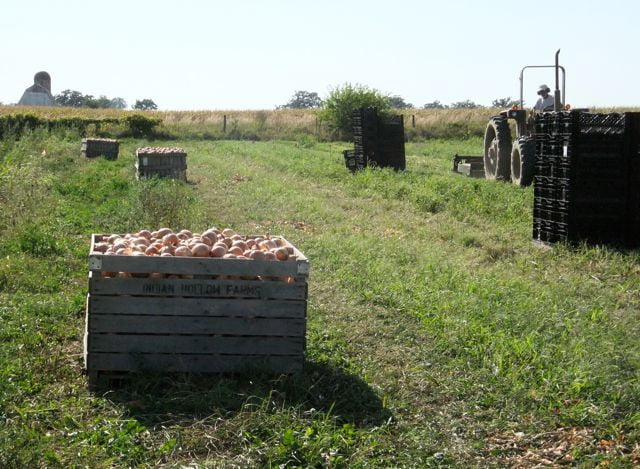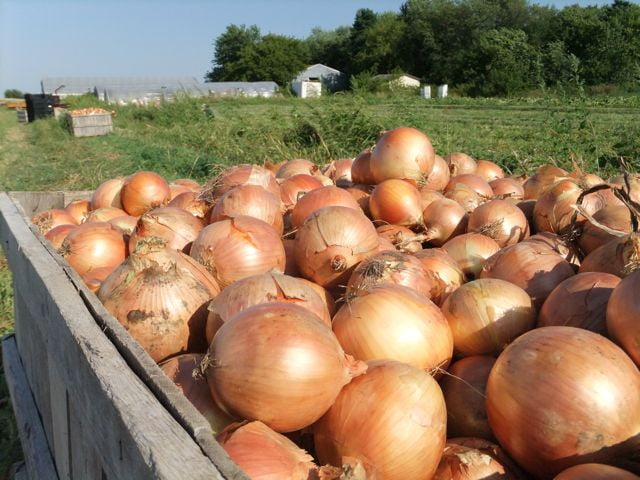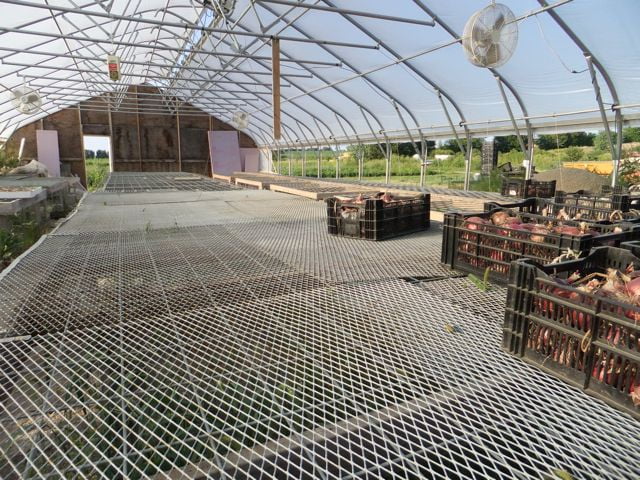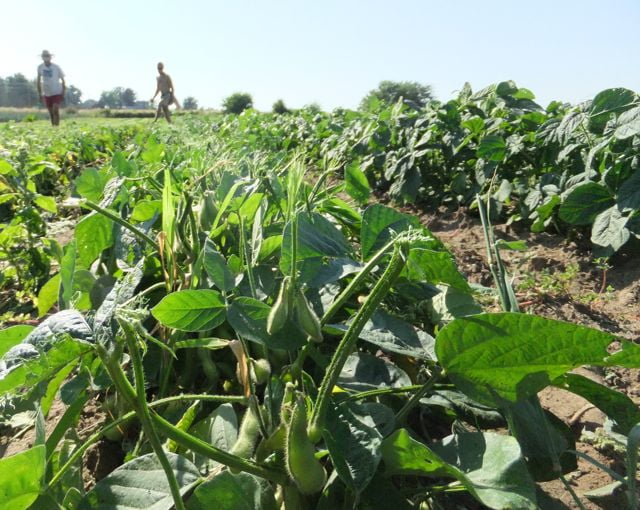Monthly Archives: August 2013
Don’t need medicine to cure these onions
- On: August 28, 2013
 0
0
We found two ways to save effort this week. It was an unusually hot and busy week, and both changes were welcomed by our work crew.
The recent dry weather has allowed us to cure our onions in the field instead of hauling them to the greenhouse. Their growth is finished and the leaves have dried down. At harvest, we pull the onions out of the ground and leave them on the soil surface for a few hours to wither the roots. Usually, we pile them into shallow black crates, then haul them into the greenhouse to dry completely, then carefully transfer them into big wooden bins.
Onions are heavy, right? Skipping the greenhouse step saved so much effort. The onions look good. I hesitate to write that after 80% of the crop rotted last year. Let’s keep our fingers crossed.
After curing for several days in the field, the onions went straight into wooden bins for storage. On the right side of the field are stacks of plastic crates for gathering onions during harvest. Steve mows weeds now that the onions are collected.
The yellow onions sized up nicely this year. We’ll send this type after the shorter-season Walla Walla and white onions are done.
The greenhouse is almost empty right now. Usually every bench is filled with curing onions.
For our second innovation this week, Steve mowed the tops off our edamame plants before harvest. We usually chop them off with a machete. The pods set beautifully in a dense clusters at the base of the plants, allowing Steve to mow the leaves without damaging the pods.
Each simple change was appreciated by our work crew during a hot and busy week.
Edamame plants just before harvest. You can see the mowed, feathered tops of the plants in this row. The row to the right is unmowed.
Veggie List and Veggie Notes
1 melon (watermelon OR crenshaw OR honeydew)
sweet corn, probably 6 ears
edamame (edible soybeans), 1 bundle
slicing tomatoes, 5 lb
Walla Walla onions, 1 or 2
Romano beans, 0.75 – 0.85 lb
bell pepper, 1
cherry tomatoes, 1 pint
basil, 2 sprigs
One site will get an heirloom tomato.
Next week’s box will probably contain melon, sweet corn, tomatoes, peppers and more.
Melon – Most members will get a red watermelon this week but a few sites will receive crenshaw or honeydew. Here’s some extra info on those two types. Both are specialty melons that Steve tinkers with each year so our harvests are limited.
Crenshaw melons (Outpost or Basics co-ops; oblong with yellow rind and pale orange flesh) – These melons look like muskmelons inside but have a different flavor. They’ve been excellent this year. Ready to eat.
Honeydew melons (Basics only; white rind with pale green or white flesh) – These melons need to ripen at room temperature for two days before eating.
Edamame (bundle of stems with leaves and pods) – These edible soybeans are a treat. Pull the pods from the stem and wash well. It helps to submerge the pods and rub them together. Boil in water until the pods have split and the beans are quite tender. Season with salt and pop the beans out of the pods into your mouth. This Japanese specialty is becoming more and more popular in the USA. Storage: Remove the pods from the stems promptly and refrigerate.
Cherry tomatoes – We picked a variety of colors but everyone will receive some pink or some Black Cherry tomatoes. These two varieties are our favorites right now, so we wanted to share with everyone.
Heirloom tomatoes (large tomato that’s not in the bag with other tomatoes) – The heirloom tomatoes are just beginning to ripen. If you receive one this week, please handle it gently. These fragile beauties bruise easily. You might have to ripen your heirloom tomato at room temperature for a day or two. Don’t let it get overripe.
Farm news and farm photos
- On: August 21, 2013
 0
0
We’re in the thick of our summer work. I wish we were finished planting but Steve is still nurturing new seedings out of the ground. It is tricky to keep young seedlings moist during dry weather. Several critical carrot and winter radish plantings failed and needed re-seeding. We are grateful that we can get replacement seed shipped to us quickly. The latest radish planting is coming up nicely. It’s a relief. Otherwise, our crew is busy with harvests and weeding. All our crops feel heavy right now: melons, tomatoes, onions. Steve notices the melons the most.
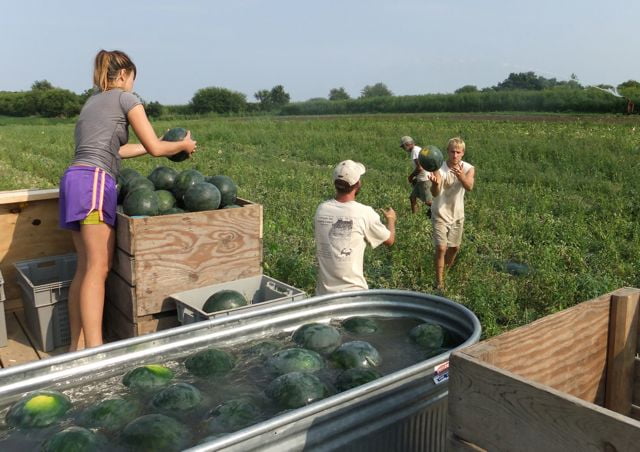
It takes a crowd to harvest watermelons.
Steve (furthest in back) carefully chooses ripe melons. He tosses to David, who tosses to Kyle, who tosses to Brianna on the wagon, who washes the melons. Steve is 65 years old but in great shape. Nonetheless, he’s already asleep because he picked 12,000 lb of melons this week and expects to pick another 4,000 lb tomorrow. You can see white spray from the irrigation gun in the top right corner of the photo above. Steve and the others were at the edge of the irrigation mist during melon harvest, the perfect place to be on a hot day.
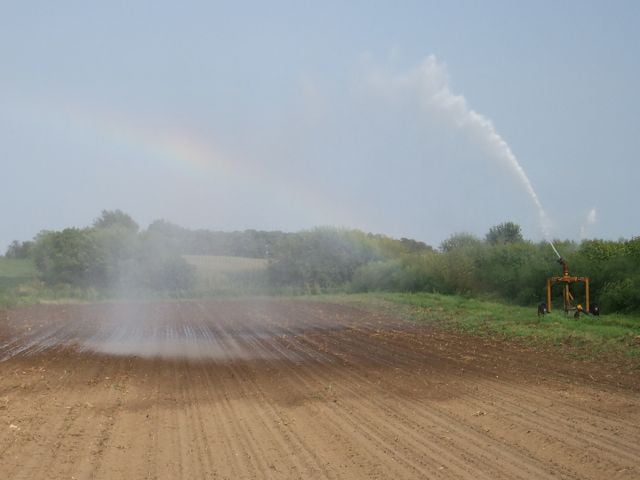
Traveling irrigation gun with rainbow.
We’re back to irrigating all our crops. There’s been little rain for 8 weeks. We coasted for a while on the heavy rains that came in June, then cool weather protected the plants from stress for a few more weeks. At this point our crops will not grow without extra water. We are counting on our strong irrigation well which pulled us through last year’s drought.
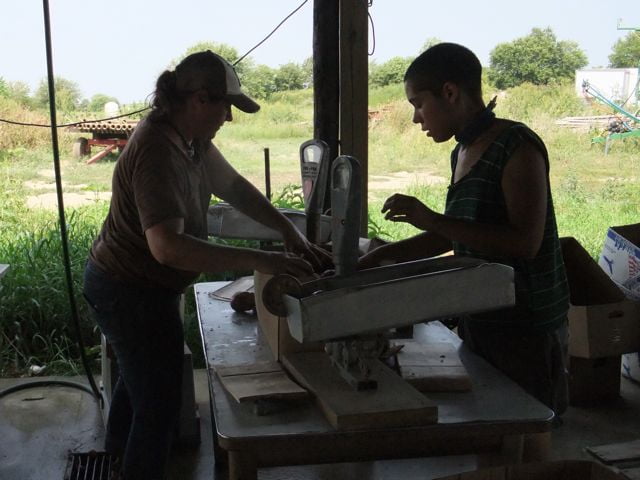
Blue and Boi use tip scales to weigh potatoes for the CSA boxes.
Our outdoor packing shed is another good place to be during hot sunny days.
Veggie List and Veggie Notes
1 melon (watermelon OR muskmelon OR crenshaw)
sweet corn, about 5 ears
“new” red potatoes, 3.25 – 3.5 lb
mixed slicing and plum tomatoes, 3 lb
white onion, 1 large
Romano beans, 1.1 lb
red Italian frying peppers, 2 or 3
#2 grade red bell peppers, 0 or 1
green leaf lettuce, 1
parsley, 1 bunch
You will receive 1 or 2 squash if we can fit them in your box.
Next week’s box will probably contain watermelon, tomatoes, peppers, onions, basil and more
Melons – We grow a variety of different melons and will continue to rotate the types among the pick-up sites. Red watermelon are traditional seeded varieties. Yellow watermelons are smaller with very sweet flesh and a softer texture than red watermelons. You know our muskmelons by now – we’ve sent them for several weeks because they’ve been quite tasty. One site (Evansville) will get crenshaw melons this week. These look like muskmelons but have a different flavor.
“New” red potatoes – The potatoes are from Chris Malek of Malek Family Stewardship Farm. They were harvested young enough that the skins have not set but (unlike most new potatoes) they were grown to full size. The skins are fragile so handle carefully while cooking. I boiled a pot until just cooked and they made fabulous potato salad. Chris advises that you refrigerate these potatoes because they lose moisture very readily at this stage. Don’t overcook them.
White onion – We’re sending white onions for a change from Walla Wallas. The white onions are more pungent than Wallas and have low moisture so they will fry, although they do not fry as well as yellow storage onions.
Romano beans – Steve asked me to write that the Romano beans are at full maturity and will hold up to a braising recipe. These are lovely beans, nicer than the batch we sent two weeks ago.
A fresh pair of hands
- On: August 14, 2013
 0
0
We hired a new worker to help Steve with his varied tasks, especially machinery repair and tractor work. Larry comes to us with broad experience, having run his own small business. He wasn’t scared off by our motley used equipment. He and Steve share a sense of humor. Larry bought a $6 set of feeler gauges for fine-tuning engines. Steve took the tool in his hands and said, “These are nice but I don’t know how to use them if they aren’t rusty.” They both cackled for a while. It was a guys-who-fix-things joke.
Steve knows how to do everything. He just can’t get it all done himself so he needs Larry’s help. Of course, all our employees fit that description. We have a long list of projects lined up for Larry.

Steve and Larry have this job under control.
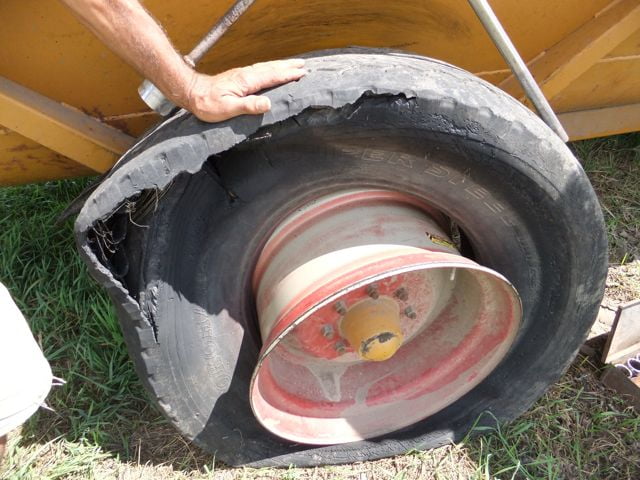
Steve says this tire is currently the worst of the 160 tires we have on our farm.
When Should You Refrigerate Tomatoes?
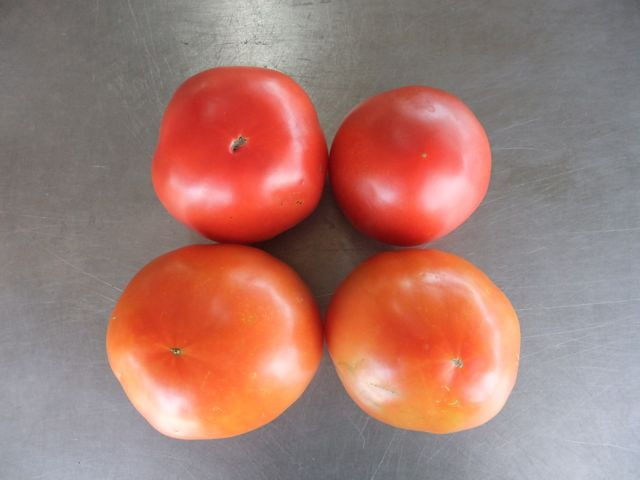
Ripe tomatoes (top) and less-ripe tomatoes (bottom).
As usual, we have packed a mix of ripe and less-ripe tomatoes so you can stretch them through the week. The top two tomatoes in the photo are ready to eat. The bottom tomatoes need to ripen at room temperature for a few days. Put on your counter or keep in a brown paper bag.
Tomatoes retain their best flavor and texture when stored at room temperature, no lower than 55oF. However, you should refrigerate your tomatoes if they are fully ripe and you don’t expect to eat them right away. It is better to sacrifice a little flavor and texture than lose your tomatoes to rot. Also, fully-ripe tomatoes are less sensitive to chilling injury.
#2 Grade Red Bell Peppers
I write about pepper grading every year. Returning members can say “yeah, yeah” and skip ahead. New members, please read.
Many of the red bell peppers we send in the CSA boxes will be our #2 grade. We do this to avoid waste and to deliver good value to our CSA members. The #2 grade peppers are excellent eating quality, but are not quite pretty enough to sell to stores. As a result, we place a much lower value on these peppers. This allows us to provide generous amounts of red bell peppers over the course of the season, about three times the amount we could provide if we only gave #1 grade. We feel this is a good exchange, even if it means you occasionally open a pepper and find that it needs trimming. Here are the reasons that peppers are downgraded from #1 grade to #2 grade:
1. They may have a minor blemish, or
2. They may have minor insect damage, or
3. They may be very ripe and beginning to wrinkle. (These are especially sweet and delicious as they are fully ripe. These cannot be sold to stores because their shelf life is short. You will find that the texture is less crisp than a #1 grade pepper, but the flavor more than makes up for it.)
4. They might be partially red and partially green.
5. Others are just too small.
The eating quality is fine (or excellent) for all these #2 peppers. We throw away all peppers that we suspect have rot inside (although one may occasionally slip through in either #1 or #2 grade.) Today’s peppers are #2 grade.
Veggie List and Veggie Notes
muskmelon, 1
sweet corn, 6 ears
slicing tomatoes, 4 lb
green leaf lettuce
#2 grade bell peppers, 2, red or ivory
Walla Walla onions, 1 or 2
garlic, 1 head
oregano, 1 small bunch
You will get one or two of these items: broccoli OR eggplant OR cucumbers/pickles OR cherry tomatoes
Next week’s box will probably contain melon, tomatoes, peppers, lettuce, sweet corn, onions, parsley and more.
Muskmelon – Don’t worry if you haven’t received a watermelon from us yet. We send more muskmelons at the beginning of melon season while their flavor is at its best.
Garlic – The garlic is from John Hendrickson of Stone Circle Farm. John supplies our garlic bulbs and scapes.
Broccoli – These heads are from a spring planting that drifted away from its usual schedule. That can happen in hot weather. It’s so unexpected to have broccoli in mid-August. The uneven heads are typical of summer broccoli. Steve says you might need to trim a bit, and to watch for green “worms” hidden in the heads. Submerge the broccoli in water, shake, and they will float free. I’m making it sound horrid but it’s actually nice broccoli.

